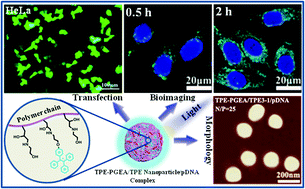Functionalized PGMA nanoparticles with aggregation-induced emission characteristics for gene delivery systems†
Abstract
Cationic polymers are considered as potential gene carriers due to their intrinsic ability to compact pDNA. Generally, cationic vectors lack the abilities of long-term tracking and real-time imaging. Ethanolamine (EA)-functionalized poly(glycidyl methacrylate) (PGMA), namely BUCT-PGEA, has recently been reported as an effective gene carrier because of its low cytotoxicity and good transfection efficiency. In this work, a series of well-defined star-like PGMA-based cationic vectors (TPE-PGEA/TPE) with plenty of flanking hydrophobic fluorophore tetraphenylethene (TPE) groups was proposed for the development of efficient multifunctional gene delivery systems. TPE-PGEA/TPE polymers could self-assemble into cationic nanoparticles, show bright cyan fluorescence in aqueous media and display aggregation-induced emission phenomena. Compared with TPE-PGEA, TPE-PGEA/TPE nanoparticles had a largely improved transfection performance. In addition, such nanoparticles also possessed the property of real-time imaging, which can help to understand the mechanism of intracellular behavior.


 Please wait while we load your content...
Please wait while we load your content...